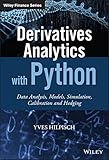Derivatives analytics with Python : data analysis, models, simulation, calibration and hedging / Yves Hilpisch.
Series: Wiley finance seriesPublisher: Hoboken : Wiley, 2015Edition: 1Description: 1 online resourceContent type:- text
- computer
- online resource
- 9781119037934
- 111903793X
- 9781119038009
- 1119038006
- 9781119038016
- 332.64/5702855133 23
- HG6024.A3
Includes bibliographical references and index.
Series; Title page; Copyright; Preface; Chapter 1: A Quick Tour; 1.1 Market-Based Valuation; 1.2 Structure of the Book; 1.3 Why Python?; 1.4 Further Reading; Notes; Part One: The Market; Chapter 2: What is Market-Based Valuation?; 2.1 Options and their Value; 2.2 Vanilla vs. Exotic Instruments; 2.3 Risks Affecting Equity Derivatives; 2.4 Hedging; 2.5 Market-Based Valuation as a Process; Notes; Chapter 3: Market Stylized Facts; 3.1 Introduction; 3.2 Volatility, Correlation and Co.; 3.3 Normal Returns as the Benchmark Case; 3.4 Indices and Stocks; 3.5 Option Markets; 3.6 Short Rates
3.7 Conclusions3.8 Python Scripts; Notes; Part Two: Theoretical Valuation; Chapter 4: Risk-Neutral Valuation; 4.1 Introduction; 4.2 Discrete-Time Uncertainty; 4.3 Discrete Market Model; 4.4 Central Results in Discrete Time; 4.5 Continuous-Time Case; 4.6 Conclusions; 4.7 Proofs; Notes; Chapter 5: Complete Market Models; 5.1 Introduction; 5.2 Black-Scholes-Merton Model; 5.3 Greeks in the BSM Model; 5.4 Cox-Ross-Rubinstein Model; 5.5 Conclusions; 5.6 Proofs and Python Scripts; Notes; Chapter 6: Fourier-Based Option Pricing; 6.1 Introduction; 6.2 The Pricing Problem; 6.3 Fourier Transforms
6.4 Fourier-Based Option Pricing6.5 Numerical Evaluation; 6.6 Applications; 6.7 Conclusions; 6.8 Python Scripts; Chapter 7: Valuation of American Options by Simulation; 7.1 Introduction; 7.2 Financial Model; 7.3 American Option Valuation; 7.4 Numerical Results; 7.5 Conclusions; 7.6 Python Scripts; Notes; Part Three: Market-Based Valuation; Chapter 8: A First Example of Market-Based Valuation; 8.1 Introduction; 8.2 Market Model; 8.3 Valuation; 8.4 Calibration; 8.5 Simulation; 8.6 Conclusions; 8.7 Python Scripts; Notes; Chapter 9: General Model Framework; 9.1 Introduction; 9.2 The Framework
9.3 Features of the Framework9.4 Zero-Coupon Bond Valuation; 9.5 European Option Valuation; 9.6 Conclusions; 9.7 Proofs and Python Scripts; Note; Chapter 10: Monte Carlo Simulation; 10.1 Introduction; 10.2 Valuation of Zero-Coupon Bonds; 10.3 Valuation of European Options; 10.4 Valuation of American Options; 10.5 Conclusions; 10.6 Python Scripts; Notes; Chapter 11: Model Calibration; 11.1 Introduction; 11.2 General Considerations; 11.3 Calibration of Short Rate Component; 11.4 Calibration of Equity Component; 11.5 Conclusions; 11.6 Python Scripts for Cox-Ingersoll-Ross Model; Notes
Chapter 12: Simulation and Valuation in the General Model Framework12.1 Introduction; 12.2 Simulation of BCC97 Model; 12.3 Valuation of Equity Options; 12.4 Conclusions; 12.5 Python Scripts; Notes; Chapter 13: Dynamic Hedging; 13.1 Introduction; 13.2 Hedging Study for BSM Model; 13.3 Hedging Study for BCC97 Model; 13.4 Conclusions; 13.5 Python Scripts; Notes; Chapter 14: Executive Summary; Appendix A: Python in a Nutshell; A.1 Python Fundamentals; A.2 European Option Pricing; A.3 Selected Financial Topics; A.4 Advanced Python Topics; A.5 Rapid Financial Engineering; Notes; Bibliography; Index
'Supercharge options analytics and hedging using the power of Python Derivatives Analytics with Python shows you how to implement market-consistent valuation and hedging approaches using advanced financial models, efficient numerical techniques, and the powerful capabilities of the Python programming language. This unique guide offers detailed explanations of all theory, methods, and processes, giving you the background and tools necessary to value stock index options from a sound foundation. You'll find and use self-contained Python scripts and modules and learn how to apply Python to advanced data and derivatives analytics as you benefit from the 5,000+ lines of code that are provided to help you reproduce the results and graphics presented. Coverage includes market data analysis, risk-neutral valuation, Monte Carlo simulation, model calibration, valuation, and dynamic hedging, with models that exhibit stochastic volatility, jump components, stochastic short rates, and more. The companion website features all code and IPython Notebooks for immediate execution and automation. Python is gaining ground in the derivatives analytics space, allowing institutions to quickly and efficiently deliver portfolio, trading, and risk management results. This book is the finance professional's guide to exploiting Python's capabilities for efficient and performing derivatives analytics. Reproduce major stylized facts of equity and options markets yourself Apply Fourier transform techniques and advanced Monte Carlo pricing Calibrate advanced option pricing models to market data Integrate advanced models and numeric methods to dynamically hedge options Recent developments in the Python ecosystem enable analysts to implement analytics tasks as performing as with C or C++, but using only about one-tenth of the code or even less. Derivatives Analytics with Python -- Data Analysis, Models, Simulation, Calibration and Hedging shows you what you need to know to supercharge your derivatives and risk analytics efforts'-- Provided by publisher.
Description based on print version record and CIP data provided by publisher.
There are no comments on this title.

